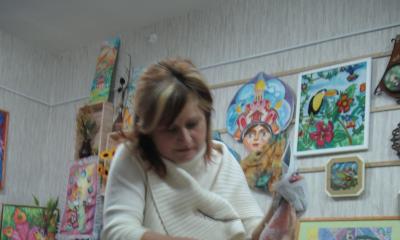The use of computer technology in chess classes
Poddubnaya Olesya Alexandrovna, chess coach
Your attention is given a description of the effectiveness of the use of information and communication technologies (ICT) in teaching children to play chess.
The use of information and communication technologies in educational process is a current issue modern education. ICTs are the leading tool for human information activity in the information society. Currently, 85% of children aged 7 to 17 use a computer, and many of them are constantly surfing the Internet. Therefore, today the interest in the virtual acquisition of knowledge is one of the powerful motives of students for knowledge. The stage of interest in learning is enriched by increasing the possibility of perception, the development of imagination and emotions. Today it is necessary that every teacher in any field could prepare and conduct a lesson using ICT. It is visual, beautiful, colorful, informative, interactive, saves the time of the teacher and pupil, allows the child to work at his own pace, and the teacher to work with the student in a differentiated and individual way, makes it possible to quickly monitor and evaluate the learning outcomes.
In teaching ICT in chess classes, I successfully use MS Office programs (Word, Power Point); chess teaching and game computer programs: "Dinosaurs teach chess", "Chess with Garry Kasparov", "Chess task book for beginner chess players", "Chess etudes", "Chess Internet. Play and learning.
Extremely interesting work using the Power Point program. It leads to a number of positive effects:
- enriches the lesson with emotional coloring; psychologically facilitates the process of assimilation;
- expands the general horizons of students;
- increases the productivity of the teacher and students in the classroom.
Slides of multimedia presentations are an excellent visual material that not only enlivens the lesson, but also forms a fantasy, develops the creative and intellectual abilities of the child.
A creative teacher with computer skills can prepare a rich material for the lesson. The use of animation in slides allows the teacher to give students a clearer idea of what they heard in class. Children are happy to immerse themselves in the material being studied, tell at home about what they see on the screen.
"Dinosaurs teach chess" this game allows you to teach both a group of children and individually. This game can be played by a child from 4 to 8 years old. The game is very effective for learning. She helps to achieve basic knowledge. There are six levels in the program. When passing all six, the child reaches the level of 5-4 ranks in chess. After each lesson, children are given a practical task in the form of a game.
Chess training programs, such as "Chess Problem Book for Beginners", "Chess Etudes" contain a huge number of training tasks classified by topic and difficulty level. Training in these programs, from beginner to master, is designed for a phased study of chess tactics. Built-in game programs allow you to play the given positions, taking into account individual settings. The programs used in the classroom contain textual and graphic hints and refutation of erroneous moves, which allows students to work independently.
The use of computer tests for a lesson makes it possible to obtain an objective picture of the level of assimilation of the studied material among pupils in a short time and to correct it in a timely manner.
The results of conducting chess lessons with the use of ICT are encouraging. The children are happy to come to such classes, they are actively working. The use of computer technology allows the teacher to: fill classes with new content; maintain independence in the development of computer technologies; develop students' curiosity. Information and communication technologies expand the teacher's opportunities to introduce children to a fascinating world where they have to independently extract, analyze, present and transmit information to others; these technologies significantly increase the didactic and student-oriented parameters of the educational process.
THERE ARE the following stages in the creative development of a chess player:
A. An unprincipled game in which individual moves are made for random reasons.
B. When choosing a move, a chess player takes into account only the opponent's obvious response and is guided by too general, elementary considerations with their minimum concretization.
B. Fascination with the first combination or trap seen.
G. Accounting common perspective, but without sufficient specification.
D. A detailed calculation of the most important options, possible, of course, only with a high level of general understanding.
E. Economical thinking, the ability to combine general formulations that are convincing enough in a particular position, with the calculation of options to the end where necessary.
We illustrate the various stages of chess creativity with an example where there is only a choice between two continuations.
TARTAKOWER - RESHEVSKY
Nottingham, 1936
How should White respond to 1... B:d2+? Should they take the bishop with a rook or a king? Let's try to trace the train of thought of chess players of different qualifications.
BUT. The answer is not motivated and is due to random considerations that are not characteristic of the position.
B. With any answer, the opponent will take my knight g5. May my king be safe. I'll beat with a rook.
AT. Knight g5 I lose. It is unpleasant, of course, to bring the king out, but after 2. K: d2 Black will fall into a trap: 2. . . hg 3. hg N: e4+ 4. Q: e4. So I'll play 2. K: d2, maybe I'll jump out!
G. If my partner beats the g5-knight, I will take hg and get an attack. With 2. K: d2 I set a trap, but the option 2... N: d5 3. ed Kd4 4. Qd3 Re2 + is unpleasant. Therefore, it is more expedient to answer 2. Rx d2, leaving his king out of danger.
D. Answer 2. Kp: d2 deserves preference because: 1) it is associated with a trap; 2) no big deal 2. K: d2 N: d5 3. ed Kd4 4. Qd3 Re2+ 5. Kpcl Rxc2+ 6. Kpbl; 3) the advantage of the move 2. K: d2 will affect the options 2. . . hg 3. hg N: d5 4. Rh8 Ke7 5. R: e8+ K: e8 6. Rh1 with an attack for a piece and practical chances, or, even stronger, 3. N: f6 (instead of 3. hg) 3 . . . gf 4.hg fg 5. fg Phoebus 6. Qf6 Q: f6 7. gf Kpg8 8. Rh3 followed by a doubling of rooks and a probable draw (for example: 8. . . Ne5 9. Rdh1 Kg6 10. Rh7 Re6, 11. Rg7+ Kpf8 12. Rxg6).
E. It is necessary to capture with the king in order to be able to quickly double the rooks along the h-file after capturing the knight on g5. Of course, partner won't fall into the trap, but even in the variation 3. ed Kd4 4. Qd3 Re2+ 5. Kpcl Rxc2+ 6. Kb1 I get chances, as his pieces hang. Anyway, 2. R: d2 is completely hopeless: I won't get a real attack for the lost piece. So, without going into further details, we must decide on 2. K: d2.
Of course, there are an infinite number of transitional steps, and it is impossible to draw a precise line between them, but in general terms, our division corresponds to the main stages of chess improvement.
The teacher's efforts should be aimed at ensuring that his students gradually, as they gain experience, move from the lower stages to the higher, accessible to them according to their natural data. It would be a gross methodological error to attempt to artificially jump over the lower levels of creativity.
Particular attention should be paid to the meaning of general formulations. They free the chess player from unnecessary calculations at the board and make it easier to find specific opportunities. But if general considerations turn into dogmas, then they are harmful, because they teach superficiality. Only those general formulations that are based on practical experience chess player at a certain stage of his qualification.
We turn to the specification of teaching methods. It seems to me that from the very beginning it is necessary to proceed from the orientation towards practical exercises. It is enough to devote 15-20 minutes to getting acquainted with the moves of the pieces and the basic rules. After that, without cluttering the memory of beginners with various exercises and chess notation, they should be allowed to immediately start playing under the supervision of a teacher. No instructions on how to play expediently should be given at this stage.
After a beginner has mastered the board, one should systematically accustom him to the motivation of moves, gradually introducing him to the basics in all stages of the game. For example, the teacher invites the student to play with him. The beginner, of course, develops the game in a completely illogical way: he moves the outer pawns and then removes the rooks, jumps the knights around the board in search of prey, etc. Meanwhile, the teacher systematically develops and, say, announces checkmate on f7. The resulting mat is imprinted - and incomparably stronger than demonstrated in the classroom. Or the teacher, watching the game of two beginners, points out the simplest missed opportunities. Or in the position obtained by two students, the teacher replaces one of them and easily wins, and then offers to change colors and achieves a draw.
The latter method is especially recommended in endgame positions where the student finds himself helpless to checkmate the opponent. This applies to the middlegame as well. Let's say one of the players has a significant material advantage. The teacher replaces weak side and a planned attack against the enemy king wins.
Already at the very beginning it is possible to give general (accessible) formulations. For example, after learning in practice how to checkmate a king with a rook and a king, a formula is given: checkmate is achieved by pushing the enemy king to the edge of the board when kings are confronted. This formula, given as a conclusion from practice, prompts the thought to independently find moves by which the pushing of the king and the confrontation of kings are achieved. Using the cases when one of the opponents has one pawn left, one can go through the simplest pawn ends and explain the meaning of the tempo.
In the area of debut, one should gradually introduce oneself to the basic principles of development, refraining from explaining the significance of the center for a certain period. Of course, a lot of attention should be paid to elementary combinations in the opening, especially in connection with the weakness of the f7-square, the h5-e8 and h4-el diagonals. In the middle game, you should first study simple mating attacks and typical combinations.
The display of short games or individual positions must be used subject to the following indispensable conditions: there must be an analogy in idea with the variation just encountered at the board; the example should be taken from some game or from an etude close in nature to a practical game, it should be bright and accessible for a given level of development in terms of idea and variant design.
At the same stage of assimilation of the minimum, it is necessary to study elementary methods that facilitate the technique of calculation (the rule of the square, etc.). When the minimum is learned, familiarize those involved with the notation.
Analysis of games after the game is very useful. The loser usually seeks to prove that he was defeated due to an accidental oversight, and the winner - that he won due to a good game. This natural interest in one's own game, when the ardor of the struggle has not yet cooled down, the teacher should make the most of it. Of course, the presence of other members of the circle in such a collective analysis is also desirable.
Consulting games are very useful, during which there is a lively exchange of experience: it is especially important here that each consultant must justify the proposed move to the other. Thus, the habit of reasonable motivation of moves is developed. Sessions should be widely used. If the teacher, while giving a session, encounters an instructive position or a mistake, he should invite the participant to write down the position, and then, at the end of the session, in the presence of other participants, analyze the example.
The display of games and individual positions at this stage can be used more often. For chess players of lower qualifications, the Morphy games are very useful, where his opponents allowed typical mistakes which were effectively and convincingly used. When any outstanding match takes place, one should practice the demonstration of the individual games played in it. But at the same time, it is not necessary to show super-subtleties, but pay attention to quite understandable and instructive moments.
The lecture method, it seems to me, should pursue the goal of summing up the results of practical exercises and developing such topics as "Basic Concepts of the Opening", "Types of Combinations", "Attacking the Castling Position" and others.
In classes with a circle of higher qualification, approximately with the third category, an even greater variety in teaching methods is possible. More often it is necessary to use the demonstration of parties. It is possible to introduce a joint reading of the chess newspaper with a critical approach to the comments placed in it. Written analyzes of the adjourned game, followed by a comparison and critical evaluation of the analyzes of both opponents, are extremely useful. There are thematic tournaments on a certain opening, thematic sessions with clocks, reports of listeners on a given topic. It is useful for chess players not lower than the second category to entrust the compilation of comments to the game with their subsequent critical assessment by the teacher.
Within the framework of this article, I am deprived of the opportunity to dwell in detail on methodological issues related to the study of individual stages of the game. I will therefore confine myself to brief remarks.
In the area of the opening, one should by no means strive to become familiar with all the principles. It is useless and even harmful to study opening variations in isolation from the game as a whole and from practical play. The value of the center must be revealed gradually, as the chess player grows. The role of the mobile center is most accessible and most visible; the meaning of dominance over the central fields can be studied from abundant practical material. The teaching of modern opening variations to chess players of the lowest and even average qualifications, which is widespread in many circles, seems to be a methodical absurdity.
In the area of the middlegame. Biggest Mistake here lies in the separate teaching of tactics and strategy, that is, combinational and positional principles. The deepening of positional understanding must go hand in hand with the development of the art of combination. In particular, such important positional concepts as open lines, weak points, it is best to initially study on examples of combinations. Also, on the example of combinations, a general formulation of the most essential strategic moment can be given - the significance of the superiority of forces in a separate sector.
It is necessary to accustom to evaluate the position as a whole, taking into account all its features in the development of a specific plan. It is necessary to evaluate the position according to a certain method, taking into account the material, the position of the kings, the advantage in the center, weaknesses, open files, the mobility of the pieces, passed pawns, specific opportunities. The evaluation of the position must be thought out to the end, in such a way that all the points noted in it will come to light in the further course of the game.
As an example, let us cite the position from the party WINTER - ALEKHIN Nottingham, 1936.

Material forces are equal. White's castling position is weakened due to the advance of the c-pawn. They have a “bad” bishop on e3, constrained by their own pawns, white knights interfere with each other, and the knight on g3 has no good squares at all. White's attempt to transfer the e2-knight via gl and f3 to e5-square can be prevented by the opponent by f7-f6. The only open file, e, is more likely to be occupied by Black due to the cluttering up of its white pieces. In the center is the balance, but Black is more secure in the e4-square than White is in the e5-square. In addition to the weakness on e4, White's e3-square is also weak. If Black manages to paralyze White's attempt to activate his play with f4-f5, then his positional advantage will become decisive.
In order to teach how to correctly evaluate a position, the method of “sensations” recommended by Nimzowitsch is very useful. Let's explain it on the example of another game of the same tournament.
VIDMAR - EIVE 
An average chess player will first of all pay attention to the exposed position of the black king and on this basis will give preference to the position of white or, at best, regard it as equal. Meanwhile, the game is hopeless for White. The exposed position of the black king cannot really be used by the opponent. Black has the advantage of two bishops and a significant pawn superiority on the queenside, white has weakened white squares in the absence of a light-squared bishop.
The game was followed by: 1. Bc3 b5 2. Ra1 c5 3. Qc1 (avoiding the exchange of queens after c5-c4) 3... c4 4. Ke1 Bb7, and White is helpless against the threat of Qe4. Two moves later - 5. Kf3 g4 6. Kg5 Qf5 - they resigned. The fact that a position, from the point of view of an inexperienced chess player, safe for White, fell apart in four moves will create a sensation, and the significance of pawn superiority on the queenside and the weakness of castling squares will be vividly imprinted.
In the area of the endgame, the amount of minimum knowledge required to achieve average strength in the game is relatively small. The subtleties of the endgame are accessible only to strong chess players and can be learned with benefit for practice only with increased interest in them, for example, when analyzing your own adjourned game. For a correct account of chances in a complex endgame, where each of the partners has more than one piece, general formulations with conclusions for each type of simple endgame are important.
Infocommunication educational resources
for the preparation of social educators-organizers of chess work in RSSU
Mikhailova I. V. ( [email protected])
Russian State Social University, Moscow
The Government of Moscow, recognizing the principle of equal opportunities in the field of education for children and young people with disabilities, declared 2009 the Year of Equal Opportunities and set the task for the teaching staff to develop a system of measures to implement this principle. We emphasize that the use of chess as a learning model can become one of the innovative approaches to solving the problem of social adaptation and rehabilitation of disabled children, since in chess the result is determined by the abstract-logical outplaying of the opponent, and not by the physical activity of the individual. That is why chess as a sport is so in demand among the disabled.
However, the integration of disabled people into the educational chess environment is complicated by a number of obstacles that have a different scale and nature. In particular, there is a big problem movement of such people to participate in chess events. Technical and hygienic requirements are rising sharply. A specific modification of the workplace is required. So, when playing chess, it is often difficult for disabled people to physically make and record a move. There is also a personnel problem - in many regions of Russia there is an acute shortage of social chess teachers who understand the specifics of the mental states of such people and are able to individualize training.
In order to overcome these difficulties, employees of the Department of Pedagogy and Organization of Chess Work of the Russian State Social University designed and conducted an initial approbation of distance learning chess for disabled people, based on the use of chess computer programs and chess resources of the Internet. Consider remote and traditional form teaching the basics of adaptive chess sport to disabled people.
The learning process can be conducted under the guidance of a teacher according to the generally accepted methodology, used, for example, on the basis of the Moscow special boarding school No. 31; or be carried out remotely - using specially developed chess computer programs and telecommunications tools according to an experimental methodology on the basis of the International Center for Chess Education (ICSE), created on the initiative of the rector of the RSSU, the president of the Moscow Chess Federation, V.I. Zhukov. The MTSSHO has powerful material and technical equipment, personnel, information and software and is ready to coordinate the work of integrating Russian children into the world community with handicapped means of information and communication resources of chess. The center has 4 tournament halls for chess competitions, a computer class for 20 workstations connected to the Internet, a lecture hall with a demonstration screen and electronic chess boards, a specialized chess library, office space, a power supply unit.
It can be assumed that every personal computer with installed chess programs, tools for working with Internet chess resources and electronic chess databases has the functions of an artificial teacher's assistant. It should be noted that the main principles of this form of education are the organization of independent cognitive activity of chess players in a developed learning environment based on computer and telecommunication technologies, and prompt communication between the trainer-teacher and the student using telecommunications.
It is the cumulative action of infocommunication components that can be considered as the action of an "artificial" assistant (AI) of a social teacher-organizer of chess work. Didactic infocommunication teaching aids in chess can be classified according to their functional purpose (the nature of the educational tasks being solved). The main didactic infocommunication means of teaching in chess are:
information retrieval system (IPS) - the function of searching and providing information;
educational and methodical complexes (EMC) - the function of e-teaching;
chess computer programs (CP) and electronic textbooks (ET) - function chess game, chess problem book and textbook;
chess information, training and gaming Internet portals that perform the above functions in real time.
Let's consider the existing objects of the implementation of chess didactic infocommunication means using specific examples. IPS Chess Assistant (IPS SA) is a multifunctional system for working and analyzing chess games, which has game training. Therefore, in the process of performing at the World Chess Olympiads and other tournaments of adaptive chess sports of the highest achievements, it is of great importance to use the information retrieval function that forms the information retrieval system - IPS SA in the preparation. Compared to debut reference books, the speed of information processing when using it increases not even by tens, but by hundreds of times.
Note that the main information educational resources, regardless of the type of remote control used educational technology, are educational and methodological complexes that provide effective training of chess players. The following principles of the conceptual framework of the WCU have been singled out. This is the principle of operational feedback, inherent in all computer programs and programming individualized learning. The most popular are the EMC "Chess elective at school", created by the staff of the Department of Pedagogy and Organization of Chess Work of the RSSU and the EMC "Chess University", which have high level methodical, informational and educational materials. For teaching blind and visually impaired chess players, the EMC "Chess elective" was voiced in MP3 format.
Training programs-simulators, consisting of gaming and training CPs, involve the assimilation of new information. The main function of the CP is to develop the skills and abilities of chess mastery in all aspects of chess improvement. A variety of chess teaching material is well selected and systematized in such teaching chess programs as: "Encyclopedia of the Middlegame" (I, II, III); "Chess strategy", "Etudes for practitioners", "Encyclopedia of opening mistakes", CT-ART 3.0 (training program for chess tactics). The main function of game computer programs is to perform the function of a sparring partner. In addition, chess players successfully use game CPs in the process of training to analyze critical positions at all stages of a chess game. Among the leading chess game programs stand out "Rybka", "Deer Fritz", "Junior", "Chess Tiger".
Leading trainers-teachers use the author's ES in the preparation of their students. In our case, the ES "Thinking in Schemes" (3) was developed and tested. The need to create an electronic database according to the "Thinking in Schemes" strategy was dictated by the fact that the strategic thinking of "artificial" intelligence, implemented through the work of teaching and playing computer chess programs, turned out to be ineffective for the development of strategic thinking of a young chess player. Therefore, more than 500 examples from the practice of "natural" intelligence were structured, when the strategic thinking of world chess champions is used as a reference model in the preparation of a chess player.
An important factor that optimizes the training of chess players and expands its capabilities is the use of Internet chess resources. They consist of game, information and training portals. Among gaming portals, ICC [domain name is www.chessclub.com], Playchess and Chess Planet stand out. A powerful information resource of the Internet, which formed the virtual educational chess environment of the RSSU, was the website of our department, created last year by the faculty and students.
The formation of a theoretical concept and a practical model for the use of adaptive chess education and upbringing makes it possible to develop a complex of special knowledge, vitally and professionally necessary skills and abilities, to form a conscious attitude to one's strengths and abilities. The study of the phenomenon of the chess game as a means and mechanism for the integration of children with disabilities, carried out at the Moscow Central School of Education RSSU, and the development on this basis practical advice allows not declaratively, but really to solve many specific problems of the formation of activity competencies in this group of people.
The use of information and communication resources of chess in the process of updating the intellectual potential of children with disabilities creates more favorable integration opportunities for the practical implementation of the principle of equal opportunities in accordance with the World Program of Action for the Disabled. The use of world information, training and game chess portals makes it possible to attract highly qualified coaching and teaching staff and sparring partners to train disabled chess players in remote regions of Russia. We emphasize that software tools become valuable elements of the process of training chess players only when they are used in close connection with the methodological support of training - the use of information and communication technologies. The choice of specific didactic means used in the process of training and performance of athletes depends not so much on the material equipment of the Youth Sports School and other chess educational institutions computers and software, and above all from the use of carefully designed and precisely verified innovative teaching and upbringing methods.








